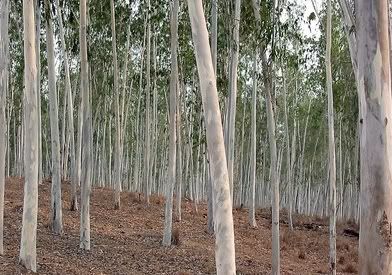Scientists develop low-lignin eucalyptus trees that store more CO2, provide more cellulose for biofuels

Under the auspices of Taiwan's National Science Council, staff members at the Taiwan Forestry Research Institute (TFRI) under the cabinet-level Council of Agriculture and North Carolina State University in the United States carried out the gene modification project that not only creates eucalyptus with a higher than normal CO2 absorptive capacity, but also causes them to produce less lignin and more cellulose.
TFRI researcher Chen Zenn-zong explained that cellulose, hemicelluloses, and lignin in trees are all created from carbon elements. However, only cellulose can be used in commercial processes of pulp manufacturing and bio-ethanol extraction. Lignin is the 'glue' that holds cellulose together. Breaking down the lignin barrier is a major obstacle for the production of cellulosic ethanol.
The idea behind the whole project is to increase the value of genetically-modified eucalyptus to related industries, so we adjusted the ratio of cellulose and lignin. Meanwhile, we enhance the tree's capacity in absorbing CO2 to reduce greenhouse gases, so that more trees planted for production, the more CO2 are consumed. - Chen Zenn-zong, Taiwan Forestry Research InstituteWith every eucalyptus carrying 18 percent less lignin and 4.5 percent more cellulose, Chen estimated that a pulp factory with an annual output of 1 million tons could generate extra revenues of NT$1. 2 billion (about US$36 million) every year.
Eucalyptus is a fast-growing tropical tree species used as a biomass source for bioenergy, and for pulp and paper manufacturing. Major research efforts are under way to map the tree's genome with the aim to improve it as an energy crop. Eucalyptus is on the agenda of the U.S. Department of Energy's Joint Genome Institute (DOE JGI), with an international team working on increasing biomass production and the carbon sequestration capacities of the species (more here):
 energy :: sustainability :: bioenergy :: biofuels :: ethanol :: cellulose :: carbon sink :: biomass :: biomass-to-liquids :: pyrolysis :: co-firing :: energy crops :: eucalyptus ::
energy :: sustainability :: bioenergy :: biofuels :: ethanol :: cellulose :: carbon sink :: biomass :: biomass-to-liquids :: pyrolysis :: co-firing :: energy crops :: eucalyptus :: So far, researchers have succeeded in developing high yield varieties. But this is the first time that the eucalyptus tree has been modified in a way that allows it both to store more carbon while at the same time yielding less lignin.
Earlier, geneticists and plant biologists succeeded in creating low-lignin poplar and willow (more here), as well as sorghum (earlier post) with the specific aim of improving pulping and ethanol production respectively.
With an emerging global carbon and biomass market, it becomes interesting to develop crops that sequester more CO2. They can be used as carbon sinks in afforestation and reforestation efforts and fetch carbon credits. Alternatively, with their high biomass yields, they will be used more and more for the production of next-generation biofuels. These include cellulosic ethanol, and fuels obtained from pyrolysis (bio-oil) and from biomass-to-liquids processes resulting in synthetic biofuels (gasification and synthesis by the Fischer-Tropsch process).
Eucalyptus is an interesting crop for the production of solid biofuels as well (woody biomass), that can be co-fired with coal or used in dedicated biomass power plants. Estimates show that there is enormous potential for the establishment of eucalyptus plantations in the tropics. A European project analysing the production of 'green steel' based on utilizing biomass from the tropics indicated that some 46 million hectares of land are available in Central Africa alone. In Brazil, another 46 million hectares are suitable. The land in question can sustain eucalyptus plantations without any major negative environmental footprint (previous post).
References:
China Post: Gene-modified eucalyptus ingests more CO2 - September 14, 2007.
Biopact: Scientists release new low-lignin sorghums: ideal for biofuel and feed - September 10, 2007
Biopact: Joint Genome Institute announces 2008 genome sequencing targets with focus on bioenergy and carbon cycle - June 12, 2007
Biopact: Virginia Tech researchers receive $1.2 million to study poplar tree as model biomass crop - June 26, 2007
Biopact: Celebrity spotting: Marc Van Montagu and GM energy crops - July 05, 2007
Biopact: Green steel made from tropical biomass - European project - February 08, 2007
 --------------
--------------
 A group of Spanish investors is building a new bioethanol plant in the western region of Extremadura that should be producing fuel from maize in 2009. Alcoholes Biocarburantes de Extremadura (Albiex) has already started work on the site near Badajoz and expects to spend €42/$59 million on the plant in the next two years. It will produce 110 million litres a year of bioethanol and 87 million kg of grain byproduct that can be used for animal feed.
A group of Spanish investors is building a new bioethanol plant in the western region of Extremadura that should be producing fuel from maize in 2009. Alcoholes Biocarburantes de Extremadura (Albiex) has already started work on the site near Badajoz and expects to spend €42/$59 million on the plant in the next two years. It will produce 110 million litres a year of bioethanol and 87 million kg of grain byproduct that can be used for animal feed.








0 Comments:
Post a Comment
Links to this post:
Create a Link
<< Home